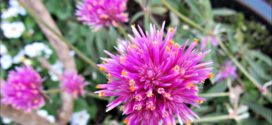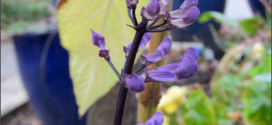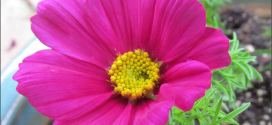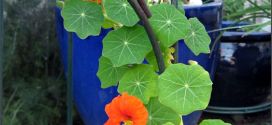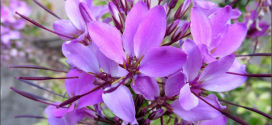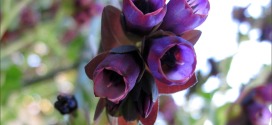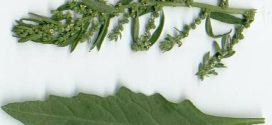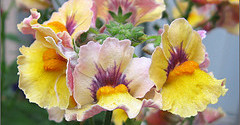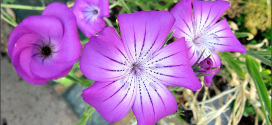Globe amaranth is a compact annual that typically grows 12-24” tall on upright branching stems. The true flowers are insignificant, tiny, white to yellow trumpets that are only visible close up. It is the bright magenta bracts arranged in globose, papery-textured, clover-like flowerheads that provide the real show in a long summer to frost bloom. Cultivars expand the range of …
Read More »Tag Archives: annual
Gerbera Daisy
New to our Sunnyvale garden in 2020 are Gerbera daisy flowers. The blooms are large (4 inches across) and have a central disk that can be yellowish, light-bronze, or dark in color. This disk is surrounded by rays that come in a variety of colors. The colors are most commonly yellow, red, or orange. However, growers have also produced varieties …
Read More »Mona Lavender Plectranthus
Plectranthus ‘Mona Lavender’. Winter hardy to USDA Zone 10 where it is easily grown in humusy, medium moisture, well-drained soils in part shade. Best with regular and even moisture. Year-round temperatures of 60-80 F. Trim off new stem tips regularly to retain compact shape and form. Remove flower spikes after bloom.
Read More »Cosmos
Common Cosmos, Mexican Aster. Cosmos are annuals, grown for their showy flowers. The flowerheads may be bowl– or open cup–shaped and are atop of long stems. Cosmos are easy to grow and make good border or container plants. They make for good decorations in flower arrangements and also attract birds, bees, and butterflies to your garden. Family: Asteraceae (ass-ter-AY-see-ee) (Info) …
Read More »Nasturtium
Tropaeolum, commonly known as nasturtium literally “nose-twister” or “nose-tweaker”, is a genus of roughly 80 species of annual and perennial herbaceous flowering plants. It was named by Carl Linnaeus and is the only genus in the family Tropaeolaceae. The nasturtiums received their common name because they produce an oil that is similar to that of watercress (Nasturtium officinale). The …
Read More »Cleome – Senorita Rosalita
Spider Flower, Spider Legs, Grandfather’s Whiskers, Cleome houtteana Family: Cleomaceae Genus: Cleome (klee-OH-me) (Info) Species: houtteana (hoot-AH-na) (Info) Synonym:Cleome hassleriana Synonym:Cleome sesquiorygalis Synonym:Tarenaya hassleriana Synonym:Cleome spinosa Synonym:Neocleome spinosa Category: Annuals Height: 36-48 in. (90-120 cm) Spacing: 18-24 in. (45-60 cm) Hardiness: Not Applicable Sun Exposure: Full Sun Danger: Plant has spines or …
Read More »Cerinthe – Blue Honeywort
Honeywort, Blue Shrimp Plant, Blue Wax Flower, Cerinthe major ‘Purpurascens’. This plant is attractive to butterflies, birds, and bees. The word “honeywort” means a plant that produces a lot of honey. Average Water Needs; Water regularly; do not overwater Family: Boraginaceae Genus: Cerinthe (ser-IN-thee) (Info) Species: major (MAY-jor) (Info) Cultivar: Purpurascens Additional cultivar information: (aka Purpurescens) Synonym:Cerinthe major …
Read More »Epazote
The epazote herb is commonly used in the cuisines and traditional medicines of central and southern Mexico and Guatemala. Epazote has a strong taste and aroma, so not everyone takes to it right away. It can be somewhat of an acquired taste, but it adds a wonderful rustic layer of flavor to many dishes. While it is best to use …
Read More »Nemeisa
Nemesia is a genus of annuals, perennials and sub-shrubs which are native to sandy coasts or disturbed ground in South Africa. Numerous hybrids have been selected, and the annual cultivars are popular with gardeners as bedding plants. In temperate regions the annual cultivars are usually treated as half-hardy bedding plants, sown from seed in heat and planted out after all …
Read More »Corncockle
Corncockle is a pretty flower that bobs in the wind on slender stalks. Warning: Probably should not be planted around small children. All parts of the plant are toxic to eat. But then again, so are many other common plants such as daffodils and foxgloves. I still recommend it for Sunnyvale gardens. The Corncockle originated in Europe where it grew …
Read More »